A Scottish town planner from the 1920s fascinated by complexities of colonial Bombay inspires a Mumbai-based architect to jam with a Scottish archivist to imagine what could have been
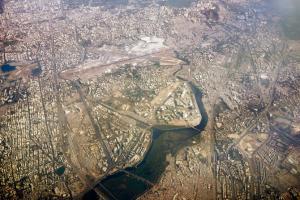
Aerial photograph of Dharavi to Powai
Professor Patrick Geddes wrote in his Note on Bandra, a document currently housed at the Maharashtra State Archives in Kala Ghoda: ‘The entrance to this town [Bandra] from the Causeway [today’s Mahim Causeway] is quite insufficient, since it is also the exit and entrance gate of Bombay. Widening to 80 feet is desirable…’
ADVERTISEMENT
Anyone who has been stuck in a jam at St Michael’s Church junction would realise that Geddes saw the future before it unfolded, foreseeing the challenges of colonial India’s fast-growing urban centres as far back as a century ago.
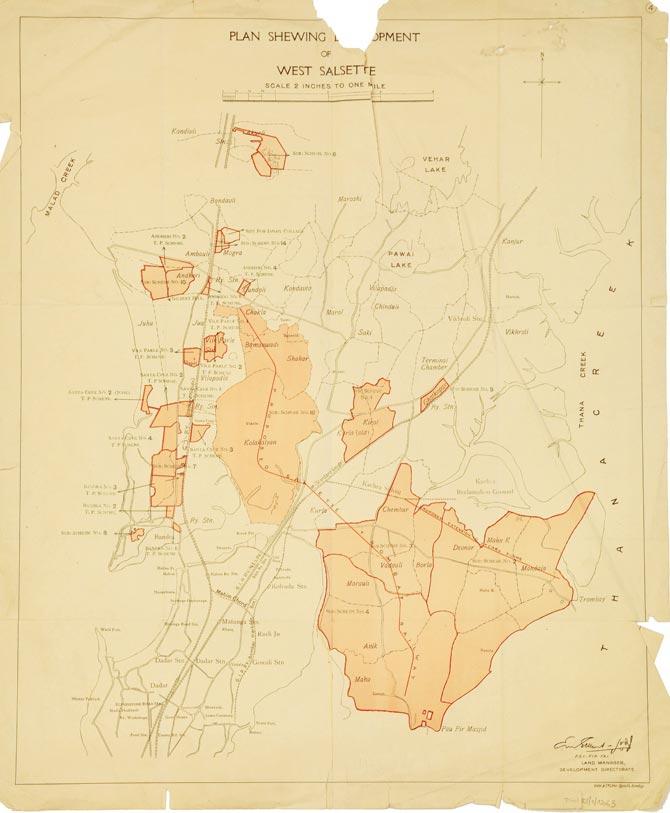
January 2019; Archival Map - Plan Showing Development of West Salsette, early 20th Century. This map was part of Patrick Geddes’ personal collection acquired during his tenure in Bombay (1914 -1924). The map, currently part of the Patrick Geddes Papers at the University of Strathclyde, shows the same area as the aerial photograph, almost exactly 100 years ago. The airport was not imagined at the time, and the ground was to be occupied by the proposed Salsette-Trombay Railway. Aerial pics/robert stephens
Robert Stephens, Mumbai-based American architect and visual artist has been poring over this document and other notes by the Scottish scholar for the months. He is joined by Elaine MacGillivray, project archivist at University of Edinburgh, who is in India to share about the Evergreen Project through a series of public lectures. Both are part of a unique initiative to bring Geddes' archival collections to a larger audience, especially in India.
After Ahmedabad, Stephens will be moderating an illustrated talk with MacGillivray in Mumbai early next week. This will be accompanied by an exhibition of documents dating back to the 20th century, juxtaposed with Stephens’ aerial photos of the exact same locations that the notes refer to. This is being called The Evergreen Project, a Wellcome Trust research resources funded initiative between the Universities of Edinburgh and Strathclyde.
Geddes first visited India in 1914, at the invitation of the then Governor of Madras, Lord Pentland. Between 1915 and 1922, he prepared a series of town planning reports for Indian cities, including Bombay. Later, he was appointed Chair of Sociology and Civics at the University of Bombay in 1919, where he remained until 1924.
"I think he loved India. He had a long-term interest in the country. He produced prolific work here, undertaking multiple projects that kept him rooted to the country for over a decade,” says MacGillivray.
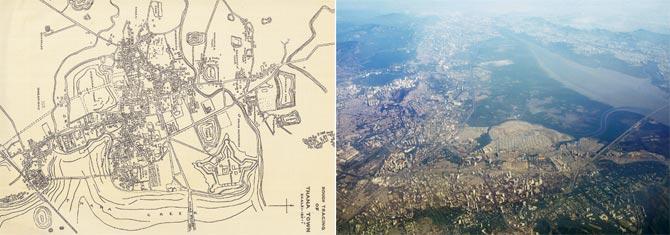
Aerial photograph of Chembur to Thane, January 2019; (extreme left) Archival Map - Plan showing proposed improvements to the Town of Thana. The map was first printed in 1915 (grudgingly by municipal authorities who disagreed with Geddes’ town planning methods), again in 1965 (apologetically by municipal authorities who felt his ideas were of value), and in 1971 (celebrated by Thane municipal authorities who idolised the town planner and his historic visit of 1915). He envisioned Thane more as a scenic locale for Bombayites, than as a dormitory town emptied daily to the island city. He suggested beautifying Masunda Tank, planting trees through the old city, and a collective Diwali celebration on a civic scale — to promote citizen engagement.
Geddes first visited India in 1914, at the invitation of the then Governor of Madras, Lord Pentland. Between 1915 and 1922, he prepared a series of town planning reports for Indian cities, including Bombay. Later, he was appointed Chair of Sociology and Civics at the University of Bombay in 1919, where he remained until 1924. "He loved India, and had a long-term interest in the country. It was his prolific work, where he flitted from one project to the next that kept him rooted to the country for over a decade," says MacGillivray.
When the two met
“While researching for my projects, including the recent work on Ahmedabad, I had referenced the archives at the University of Strathclyde on several occasions. They noticed my interest in Geddes’ work, and connected me with Elaine in 2018,” says Stephens. Interestingly, the University of Edinburgh had approached the University of Strathclyde to work collaboratively. Together they applied to the Wellcome Trust for funding and it's this successful collaboration that resulted in a 34-month project to catalogue and conserve Geddes' papers and enhance access to researchers across the globe.
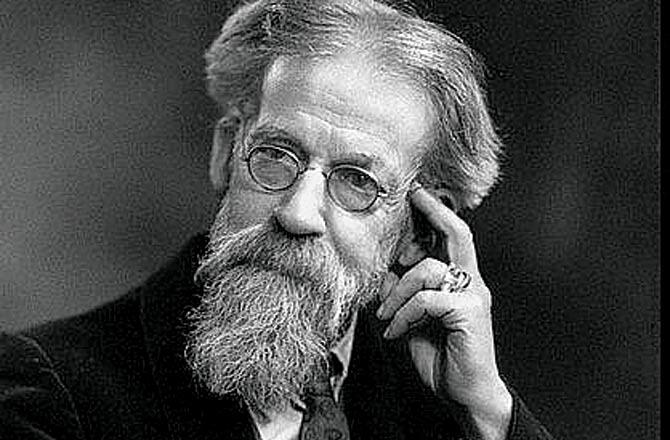
Patrick Geddes
Scot’s the word
MacGillivray, who is on her first visit to the country, is looking forward to contextualising Geddes’ plans in modern-day India. “I would have liked to have the time to visit the places Geddes visited and worked. It will allow me to develop a deeper holistic understanding of the archive material, to interpret and contextualise it more accurately, particularly in relation to the geography, geology and culture of India.”
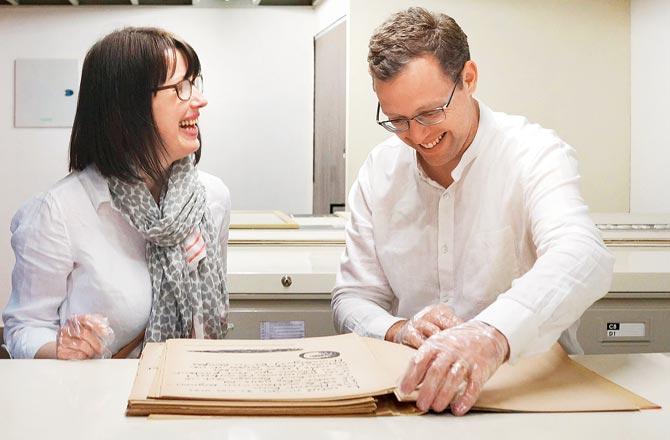
Elaine MacGillivray and Robert Stephens
Having interacted with members of his family, and studied his collection at length, MacGillivray discusses Geddes’ personality. “I think he was quite charismatic and charming, and an influencer. He was an ideas person, and that took him to all corners of India,” she reveals. “But this is also why, sometimes, his meticulous town plans weren't successful. You need to follow-up, but he was interested in too many things,” Stephens chips in, sharing that Geddes’ ideas were often expansive, and hence perceived as too ambitious to undertake. “They were dismissed as unmanageable.”
But the collaborators agree that several of his views of active citizenship continue to be relevant. “He advocated the importance to act locally, and to conserve what was historically significant provided it was functional and met and improved the needs of the people. This didn't necessarily find favour across the board,” MacGillivray reminds us. “But Geddes listened to everybody, even those he disagreed with, which is what makes his work important in that he was able to identify the functions of a city from every aspect,” Stephens adds, stressing why the archival collection possesses significant scope.
Stephens, who we think is more a Mumbaikar than most locals, is happy to share that Geddes found the island city difficult to report on because of its complexities.
What would have surprised him the most if he were to return to today’s Mumbai? “He would find it tough to believe that the original city allowed the suburbs to follow suit with regard to unplanned development,” Stephens estimates.
The incessant traffic jam at Mahim Causeway suggests Stephens may be right.
Geddes' love for the Irani café
Popular Indian-run Irani cafe-themed chain in the UK, Dishoom’s fifth outlet in Edinburgh is a tribute to Sir Patrick Geddes. When the owners were looking for connections between Scotland and India, they stumbled on his link with Bombay. He loved the city’s Irani cafes and enjoyed watching Parsi theatre. Since he spent hours at Kala Ghoda’s Sir David Sassoon Library, they created a bookish vibe to Dishoom, as if it were a reading room scattered with old maps of Bombay and Gujarat from the 19th and early 20th centuries.
Catch up on all the latest Mumbai news, crime news, current affairs, and also a complete guide on Mumbai from food to things to do and events across the city here. Also download the new mid-day Android and iOS apps to get latest updates
 Subscribe today by clicking the link and stay updated with the latest news!" Click here!
Subscribe today by clicking the link and stay updated with the latest news!" Click here!






